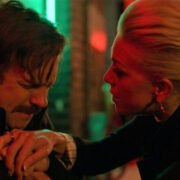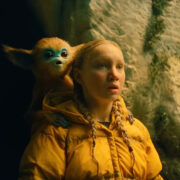Once Upon A Fantasy: Lanthimos & Tarantino’s Grand Delusions

Michael Colbert is a writer based in Portland, Maine. He…
“You are in favor. But favor is a breeze that shifts direction all the time. Then in an instant you’re back sleeping with a bunch of scabrous whores wondering whose finger’s in your arse.”
For the most part, The Favourite and Once Upon a Time in Hollywood could not be more distant. The Favourite tracks Queen Anne’s court and the power plays–and lust–running it, while Once Upon a Time indulges male fantasies in 1969 Hollywood. Though The Favourite portrays a fresher take on female power and motivation, both of these period pieces were still directed by men, Yorgos Lanthimos and Quentin Tarantino, whose visions confer a guiding aesthetic and cult status to what they touch.
And both films seem taken by the idea of the delusion, and grand ones at that. Madness and ego motivate those with (or longing for) power and clout to act. Characters perform publicly, playing out fantasies, or watching others face the consequences of their own delusions. And then they retreat to private chambers where fantasies grow and swell, where they find space to be made flesh.
I Dreamt I Stabbed You in the Eye
The production value of The Favourite suits Queen Anne’s court, but perhaps one of the most visually arresting techniques used throughout the film is the fisheye lens. In his article in the Los Angeles Review of Books, David Marno discusses how this gives us the sense of spying through keyholes on unfolding drama. In many ways, the characters are on stage, and the performance will go on whether or not we are there to witness it.
At other times, the lens captures the more unsavory, decadent displays of frivolity at hand in the court, like the goose race early in the film. A similar scene of men throwing tomatoes at a naked man is not shot with the fisheye lens but still captures the grotesqueness of the wealth. Displays like these are elaborate and decadent. Makeup is garish, recalling Queen Anne’s “badger” earlier in the film, and the velvets and denim of costumes supple and palpable. Oftentimes in both films, the performance is also edible, in cakes and alcohol and lots of it. Though England is at war, the politicians could not seem less concerned with what is happening beyond the castle.

Two of the most visually striking sequences of performance feature both of Queen Anne’s objects of affection. In the first, Sarah (Rachel Weisz) dances with Masham (Joe Alwyn). Their dance moves quickly transcend line dancing and venture into The Matrix-stylebackbends and dizzying spins and throws. The display is enough to make Queen Anne (Olivia Colman) call off the performance and ask Lady Sarah to bring her back to her apartment, where Abigail (Emma Stone), reading in the library, hears them make love.
Abigail quickly learns how to follow suit in order to garner Queen Anne’s affection. Overcome by how inviting the bed and lonely the sheets, she ends up naked in the queen’s bed. She is called back to visit the Queen, and soon her performance feels like it mimics love, which Sarah and Anne model: though Sarah relishes the power and the ability to engage in the war waging that sometimes happens in discussions and parliamentary sessions, she also demonstrates affection for the Queen in how she speaks to her of their history and how she’s hurt when eventually cut out.
Near the end of the film we find a parallel, overblown sequence: Lady Abigail drinks too much and wears similarly overwrought make-up. She laughs, demonstratively, performatively, at somebody’s jokes and returns to the Queen’s apartment, where Anne is trying to read legal documents, and she vomits in a vase. When her performance encroaches upon the private space, Queen Anne is discomfited: she regrets pushing Sarah away. She waits for the mail, for a letter that she will never get to see.
The film’s final sequence, in its spinning rabbits and close-ups of Anne and Abigail may convey Abigail’s realization of her own status relative to the Queen or the Queen’s illness, but they also can be suggestive of the delusions coming to bear on both women. In other words, Queen Anne has chosen the sweets and cakes, the saccharine Abigail, who exists for her own performance and power, and the enduring love of Sarah is nowhere to be found. She and Abigail must pay for their choices, as Sarah does from exile.
California Dreamin’
Tarantino’s film employs parries and fake-outs to represent characters’ day-dreams. A film about Hollywood in the 1970s, Once Upon a Time in Hollywood relishes meta-narrative. The idea of the performance is everywhere, whether Rick (Leonardo DiCaprio) is on set, or watching his L.A. neighbors, Roman Polanski and Sharon Tate (Margot Robbie), or Cliff (Brad Pitt) is chauffeuring Rick around and concealing from him his private life.
Everybody in the film performs a public persona. Sometimes they even watch their own performances. Sharon Tate goes to the movies, unrecognized at first, and watches the real Sharon Tate on screen in The Wrecking Crew, a reminder of how Tate is not just a character but a person and what fate she ultimately met in history. The scene serves as an elegy for her innocence and budding career never fully realized. Theater lights melt on her face and innocent, giddy smile.

Shut out from work on set for allegations that he killed his wife, which appear true in the film during a flashback, which are unsettling considering controversy surrounding the film and allegations against Tarantino for violence against women, Cliff spends the day at Rick’s house repairing the antenna. He imagines what his day on set would have been like, how he would fight Bruce Lee and be kicked off set for the same reasons again. His day dream is elaborate, xenophobic, indulgent, a reminder of the gratuitous, cartoonish violence typical of a Tarantino movie, and in a headshake, Cliff is back on the roof, deciding that repairing the antenna is the better place for him to be.
This sequence teaches us how to understand what happens later, when Cliff goes to the Manson Family Ranch, and at the end of the film when the history of the Tate Murders that we’ve known, that maybe we’ve decided to watch this film in order to see revisited (for Manson and the Tate-LaBianca murders have an unsettling staying power in the media) are reimagined in wild strokes of violence that Tarantino promises, in gestures to the real story that come unhinged when Rick yells about their car groaning in the road and Cliff’s dog is set loose and Rick’s Italian wife Francesca screams and runs through the home.
At the end of the film, the delusion is made real. Like the Bruce Lee sequence, it marries fact – people and a story we know – with these characters’ wishes for grandeur. So when Rick is invited into the Tate home and walks the driveway, the scene has an air of the extraterrestrial, spiritual, the uncanny. For in this adjacent Once Upon a Time, the film’s counterfactual doesn’t seem too impossible.
The Films Diverge
Both films venture down the rabbit holes of the most powerful agents’ desires, yet the effects of, and echoing message from, both explorations are remarkably different.
In The Favourite, the women all face consequences. Lady Sarah is sent into exile. The Queen and Abigail come to terms with their relationship. For them, the fantasy has become real, and the taste is sour–more Queen Anne upchucking blue cake than the blue cake itself.
Yet in Once Upon a Time In Hollywood, the men are heroes. They fantasize and day dream in order to imagine a reality in which they are not a Hollywood actor and stunt double who have (sort of) seen their day already. In their imagination, they are the victors, yet they do not know what really should have happened, what was expected to befall Sharon Tate and her friends.
Their fantasy sequence, and all the actors involved in it, comes to be so that their egos may feel better. They do not know a world in which there are consequences for deluding themselves as they do. They are men not told no, and maybe the scale, the revision of history required for their delusions, conveys just how they aren’t ready to handle a world in which they come to terms with their own demise, from which the women in The Favourite cannot escape.
Does content like this matter to you?
Become a Member and support film journalism. Unlock access to all of Film Inquiry`s great articles. Join a community of like-minded readers who are passionate about cinema - get access to our private members Network, give back to independent filmmakers, and more.
Michael Colbert is a writer based in Portland, Maine. He loves horror film (his favorites are Candyman and Rosemary's Baby), and he’s a coffee addict (his favorites are Costa Rican and Ethiopian). His work has appeared in Avidly, Maine the Way, and Germinal.











